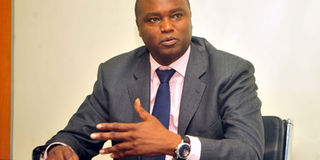Stanbic’s new boss keen to raise customer satisfaction

Mr Patrick Mweheire, the managing director Stanbic Bank Uganda. PHOTO BY STEPHEN WANDERA.
Last week, Stanbic Bank Uganda’s board of directors confirmed the appointment of Patrick Mweheire as Managing Director.
Below, Daily Monitor’s Abdulaziizi K. Tumusiime discusses with him Uganda’s banking industry and his plans.
What do you make of Uganda’s banking industry?
The industry is over banked. 25 banks for this market is a bit on the high side. You can be overbanked and still not meet the requirements of the market. When you look at the composition of the market share, the top 10 banks still account for majority of the market share and that is not going to change any time soon. Each bank has to find its niche. I think this is the challenge we have to overcome. That said, some banks have clearly identified what they want to do.
Also, the unbanked population is quite huge and the sector has not figured out how to give them correct value proposition. A lot of people want to be included in the financial sector but as an industry we have not figured out the threshold of making that feasible financially
What fresh ideas does Mr Mweheire bring to Stanbic Uganda?
My focus areas in 2015 will be; getting service right, bringing down some costs and then compete aggressively in the areas we have selected. I want Stanbic Bank to be the bank that people cherish. Our service delivery has been poor. Some of our clients think we are arrogant because we are big. So this year, I am creating a new position for head of service delivery. This is all in a bid to make us very customer centric.
I also want to make us more cost efficient. We have a very high cost to service ratio in certain segments because we have a very large branch footprint. I want us to bring down the distribution cost and cost to income ratio over time
What are some of the challenges of operating in the Ugandan banking space?
The prime lending rate, much as it has come down recently, is still very high. The prime rate in the industry is about 19 % but these are high interest rates, if you look at that on a relative basis in the region.
There is also, generally, high cost to service in the market. It is not just interest rates; it is branch network, electricity costs, running generators for ATMS etc. There is need to bring down the cost of doing business.
There is also a lot of pressure on banks to do long term funding. But if you look at the balance sheets of the banks in the country, we are all structurally funded by short term funds. So there is a structural mismatch. People ask why we cannot do 20 year loans. It is important to note that in other markets there is a certain segment of the pension industry, insurance companies that do the long term funding.
What do you think can be done to help the situation?
One of the challenges of the banks in Uganda is to establish how they can get longer term funding to do longer term lending. We are trying to explore how to partner with other institutions out there so that we can agree on risk mitigation. A good example of a private public partnership is the GET FiT programme developed by Deutsche Bank and KfW. It is a nice eco system in which you select what is doable and, what is not, and eventually mitigate risk. It has been very successful in funding projects that require up to 20 year financing. This is the type of thinking we need. But we need to start thinking about other partners that have longer term capital and how we can partner with them. For instance, how does NSSF and the funds they have come into play. Maybe there is a solution where NSSF puts some funds aside that supplements what the bank are doing.
Your appointment has been interpreted, in some circles, as a vote confidence in Ugandan banking executives. What do you make of this?
I have heard that as well. I am surprised that people did not have confidence in the Uganda banking executives. There are very many talented Ugandans. So I find it offensive when people say we are not ready. There are about five Ugandan MDs out of the 25 banks. We are not yet where we should be. The number should be at least half of the banks.
The media has reported a number of fraud cases related to Stanbic bank. How do you intend to deal with this?
There are a few initiatives we have put in place. We are rolling out a biometrics programme. We have rolled out CCTV cameras in every branch and every ATM. Most of the fraud has been through impersonation and sometimes collusion with staff. So our initiatives will bring it under control. In fact last year we incurred less than a billion in operational losses. This was down from five billion the year before.
Stanbic Uganda enjoys the enviable position of the largest bank in terms of assets and infrastructure. What has been your secret?
The Group (Standard Bank) has refocused its strategy on Africa. We are focused on sub – Saharan Africa. There are a lot of positive synergies that come with that, especially in regard to best practices and capital. We have the ability to tap into a steady base of capital and expertise. There are also lessons learnt. Currently we are collating the lessons learnt in Mozambique and Angola, in the oil and gas industry, to see how they can be relevant in the growing of our own industry.




